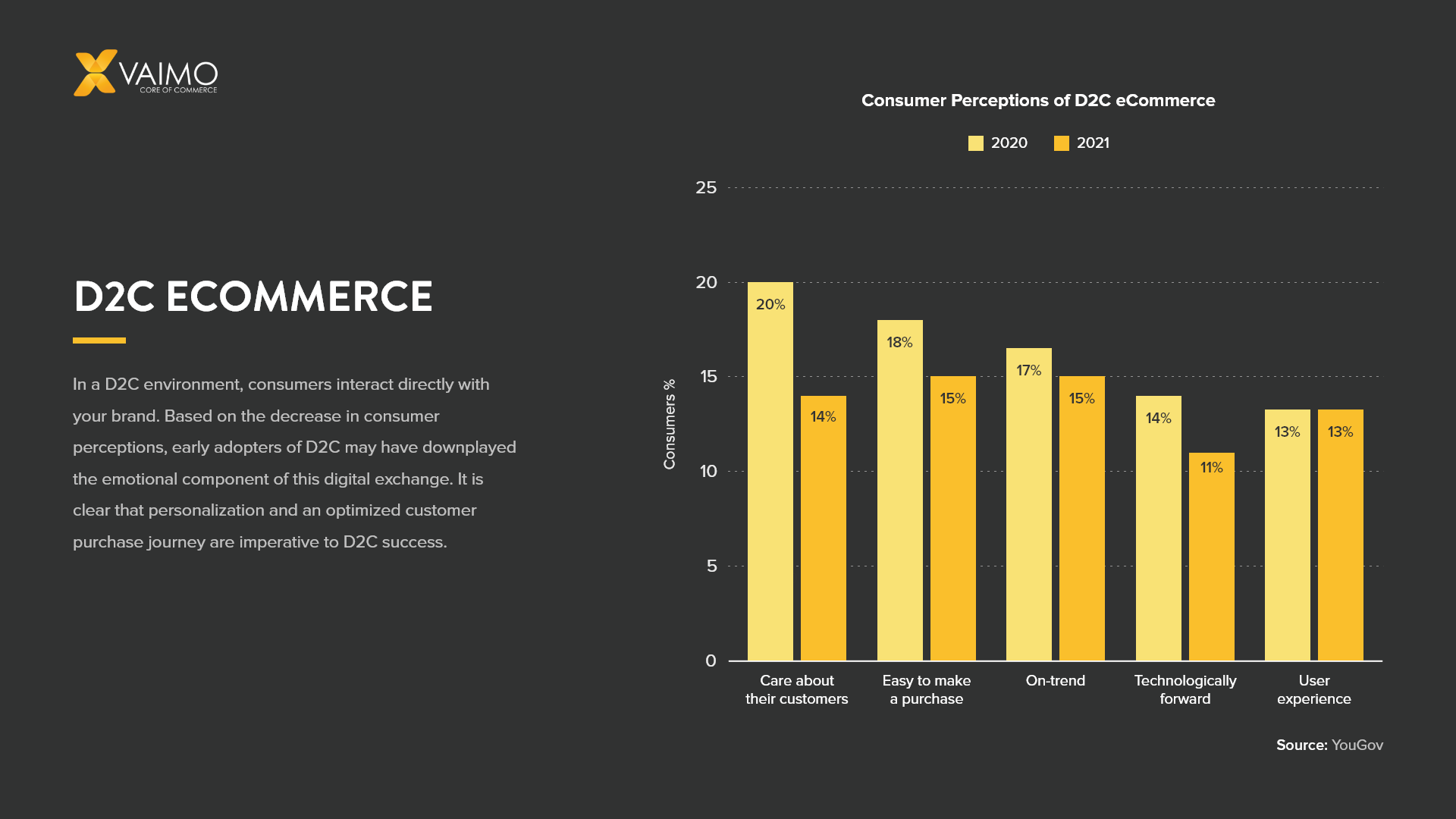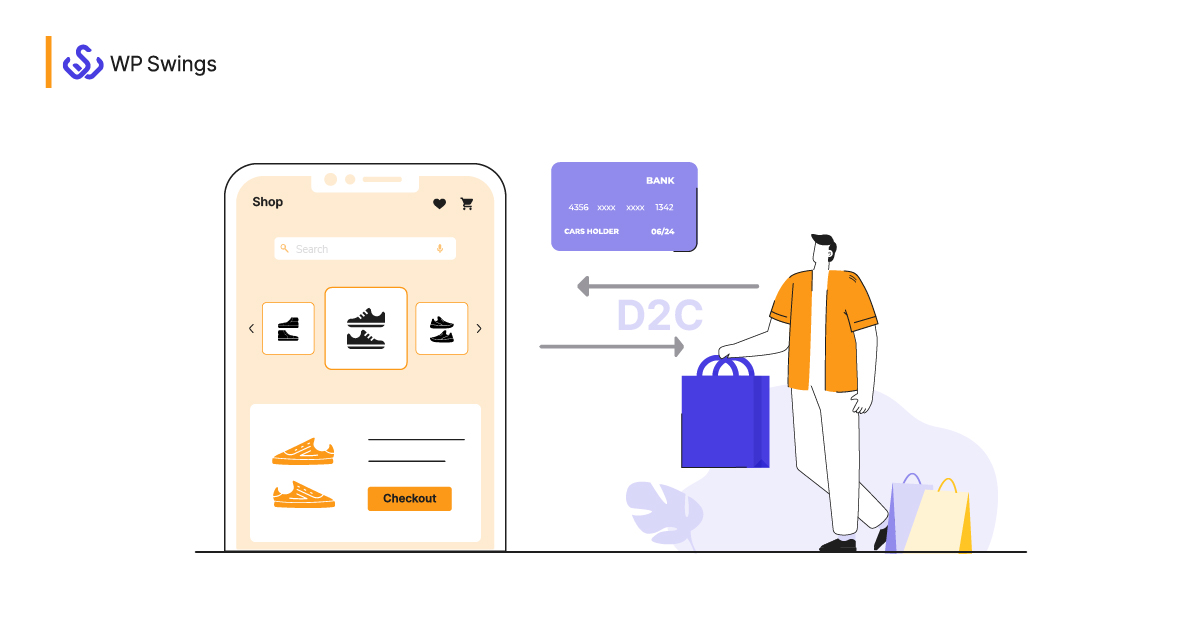Checking out the Prospective of D2C Ecommerce: A Comprehensive Overview for Organizations
The D2C ecommerce design offers a substantial change in exactly how brands involve with customers. It makes it possible for companies to bypass conventional retail channels, cultivating much deeper links and potentially boosted profit margins. Nevertheless, this approach is not without its complexities. Recognizing the subtleties of D2C ecommerce is crucial for brands aiming to prosper. What methods can they embrace to navigate this advancing landscape effectively? The solutions might redefine their business techniques.
Understanding the D2C Ecommerce Design

Key Advantages of D2C Ecommerce for Brands
The D2C ecommerce model supplies brands substantial advantages, especially relating to enhanced revenue margins. By eliminating middlemans, companies can retain a larger share of sales income. In addition, this direct partnership with consumers fosters boosted brand loyalty, motivating repeat acquisitions and long-term interaction.
Increased Revenue Margins

Improved Brand Name Commitment
Building on the financial benefits of D2C ecommerce, improved brand name loyalty becomes one more vital benefit for business involving straight with consumers. By developing a direct link, brands can promote deeper connections with their customers, getting understandings into actions and preferences. This direct communication enables for even more customized marketing strategies, which reverberate highly with consumers. Furthermore, brand names have the chance to control their messaging and customer experience, strengthening brand worths and building depend on. When customers really feel an individual link, they are a lot more most likely to return, advocate for the brand name, and take part in neighborhood engagement. Ultimately, enhanced brand commitment not just drives repeat acquisitions but additionally cultivates a passionate consumer base, further solidifying a brand name's position in the market.
Obstacles Encountered by D2C Brands
D2C brands encounter a number of significant obstacles that can impact their success. Inventory management concerns can bring about stock shortages or excess, complicating procedures and customer complete satisfaction. Additionally, marketing spending plan restrictions typically restrict the capability to successfully reach and engage target market.
Supply Management Issues
Efficient stock administration provides a powerful challenge for several brands operating in the direct-to-consumer (D2C) space. These brand names typically face rising and fall need, which can lead to overstock or stockouts, inevitably impacting customer satisfaction and income. Furthermore, the lack of sophisticated stock radar can lead to discrepancies in between actual supply levels and reported data, making complex order gratification. The varied series of products D2C brand names typically supply additionally complicates inventory administration, as variants in styles, shades, and sizes call for more precise oversight. Many D2C organizations may have a hard time with restricted warehousing capacities, leading to ineffective use of area and resources. As a result, efficient inventory administration remains a vital hurdle for D2C brands going for lasting growth and functional performance.
Advertising And Marketing Budget Constraints
Steering advertising budget plan restrictions is a considerable obstacle for lots of direct-to-consumer (D2C) brands. Minimal funds often limit these companies' ability to buy read what he said all-inclusive marketing techniques, leading to lowered presence in an affordable market. D2C brands regularly face the demand to take full advantage of roi (ROI) while targeting certain audiences effectively. This obstacle is exacerbated by rising expenses in digital advertising and the necessity to allot funds across multiple networks, including social media sites, internet search engine, and email advertising and marketing. Numerous D2C brands must introduce cost-efficient advertising and marketing services, leveraging natural development methods and influencer partnerships. Eventually, effectively steering these budget plan restraints is crucial for sustaining growth and accomplishing long-lasting success in the developing ecommerce landscape.
Approaches for Constructing an Effective D2C Ecommerce Company
As consumers increasingly look for straight links with brands, establishing an effective D2C ecommerce service requires a strategic approach that focuses on consumer interaction and trust. One effective method is to develop engaging brand name narratives that reverberate with target audiences, fostering psychological links. Utilizing social networks systems can enhance visibility and facilitate two-way interaction, allowing brand names to involve straight with customers.Moreover, individualized experiences via tailored advertising initiatives can substantially boost client retention and loyalty. Carrying out commitment programs and supplying exclusive bargains can further incentivize repeat purchases.Streamlining the acquiring procedure is necessary, ensuring a straightforward user interface that enhances the buying experience. Additionally, clear communication pertaining to shipping and returns builds trust fund and urges customer confidence.Finally, proactively seeking client feedback and reacting to it shows a dedication to improvement and customer contentment, vital components in the competitive D2C landscape.
Leveraging Innovation for Improved Client Experience
In today's affordable D2C ecommerce landscape, modern technology plays an essential function in forming consumer experiences. Companies significantly make use of sophisticated tools such as synthetic intelligence, chatbots, and personalized algorithms to improve interactions and streamline the shopping procedure. By incorporating these technologies, brands can give tailored product recommendations based on individual choices and shopping actions, cultivating an extra appealing experience.Moreover, responsive web site layouts and mobile applications guarantee that consumers can access solutions effortlessly throughout different tools. Boosted payment services, including digital pocketbooks and one-click check outs, better simplify deals, making it much easier for customers to make purchases.Data analytics likewise makes it possible for businesses to gather insights into consumer behavior, enabling continuous improvement of offerings and services. In general, leveraging modern technology not just enhances consumer satisfaction yet likewise cultivates commitment, inevitably driving long-lasting success in the click here to find out more D2C ecommerce industry.
Advertising Techniques to Drive D2C Sales
Just how can brand names properly catch the focus of customers in a saturated market? To thrive in the direct-to-consumer (D2C) landscape, brands have to employ targeted advertising strategies. Using social media platforms, brand names can involve customers with interactive web content, influencer partnerships, and user-generated articles. Customized e-mail campaigns can likewise cultivate a sense of link, providing customized promos based upon consumer behavior and preferences.Moreover, narration plays an important role in separating a brand's story, making it relatable and memorable. Brand names should invest in seo (SEO) to enhance exposure, ensuring their products are quickly visible online. Additionally, leveraging data analytics permits services to improve their marketing methods and understand consumer fads better. Eventually, a multi-channel method that integrates creative thinking with data-driven understandings can greatly improve D2C sales, allowing brands to attract attention in a crowded industry.
Future Fads in D2C Ecommerce
With the quick evolution of innovation and consumer preferences, the future of D2C ecommerce is positioned for significant makeover. Emerging trends indicate a change in the direction of hyper-personalization, where brands leverage information analytics to customize offerings to private consumer requirements. This modification boosts consumer experiences, promoting commitment and engagement.Moreover, sustainability is coming to be an important view publisher site factor, with customers progressively favoring brand names that focus on environment-friendly methods - D2C Ecommerce Agency. Companies are expected to embrace clear supply chains and sustainable materials to meet this demand.The integration of man-made intelligence and boosted fact will additionally change the buying experience, permitting customers to visualize products in their settings before acquisition. Additionally, social commerce is expected to expand, as platforms like Instagram and TikTok promote seamless shopping experiences straight within social media.These fads jointly symbolize a vibrant future for D2C ecommerce, highlighting customer-centric strategies and ingenious innovations that redefine consumer communications
Frequently Asked Questions
What Industries Benefit A Lot Of From D2C Ecommerce?
The existing question highlights markets that thrive via direct-to-consumer (D2C) ecommerce. Incredibly, style, charm, electronics, and food sectors utilize D2C versions to increase brand name loyalty, enhance consumer relationships, and maximize revenue margins properly.
Just How Do Delivering Costs Impact D2C Rates Methods?
Shipping prices significantly affect D2C rates strategies. Services have to balance these expenses with affordable pricing, taking into consideration client assumptions and profit margins. Efficient monitoring of delivery can enhance client satisfaction and drive sales in direct-to-consumer models.
What Payment Alternatives Should D2C Organizations Offer?
D2C companies should provide varied repayment alternatives, including credit/debit cards, digital wallets, and get currently, pay later services. This selection enhances consumer ease, boosts conversion rates, and accommodates various consumer preferences in the on-line shopping landscape.
Just How Can D2C Brands Manage Consumer Returns Efficiently?
D2C brands can take care of customer returns effectively by implementing user-friendly return policies, supplying prepaid shipping labels, and ensuring prompt refunds (D2C Ecommerce Agency). Clear communication and streamlined processes boost consumer contentment and encourage repeat business
What Lawful Considerations Exist for D2C Ecommerce Operations?
Legal factors to consider for D2C ecommerce procedures include compliance with consumer security laws, data personal privacy guidelines, copyright rights, and tax requirements. Brand names must browse these complexities to stay clear of legal mistakes and assure smooth procedures. By removing intermediaries, D2C brand names can use competitive pricing and cultivate an extra intimate connection with their customers.The D2C design is defined by its dependence on digital platforms, allowing brands to make use of social media, online markets, and their very own internet sites to engage with consumers directly. D2C ecommerce facilitates the collection of useful client information, making it possible for brands to tailor their offerings and advertising and marketing methods properly, ultimately driving sales and raising margins. Additionally, brand names have the possibility to control their messaging and customer experience, reinforcing brand name values and building count on. As customers increasingly look for direct links with brands, developing a successful D2C ecommerce organization needs a tactical technique that focuses on customer interaction and depend on. D2C brand names can manage customer returns successfully by applying user-friendly return policies, offering pre paid delivery labels, and ensuring prompt reimbursements.